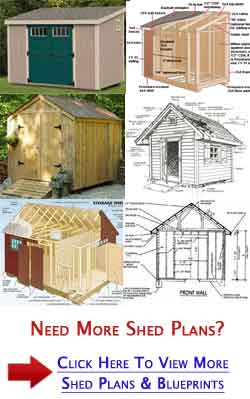

 www.gazebocreations.com
www.gazebocreations.com Introduction: Build Your Own Gable Roof Shed Thinking about adding storage, a workshop, or a hobby space to your property? Building a gable roof shed is a fantastic DIY project. This guide provides a step-by-step approach to constructing your own shed, covering everything from planning to finishing touches. Let's get started!
Step 1: Planning and Preparation Before you even think about picking up a hammer, careful planning is crucial. This stage determines the success and ease of your build.
- Shed Size and Location: Consider your storage needs and the available space on your property. Check local building codes and zoning regulations for shed size and placement restrictions (setbacks, height limits, etc.).
- Shed Design: Decide on the dimensions and style of your gable roof shed. Gable roofs are relatively simple to construct and provide good water runoff. Research different shed designs and consider factors like door and window placement.
- Obtain Blueprints/Plans: You can find free or paid shed plans online or purchase them from home improvement stores. These plans will provide detailed instructions, material lists, and cutting diagrams. I advise to get shed plans for a Gable Roof.
- Gather Tools: Ensure you have all necessary tools: circular saw, drill, level, measuring tape, square, hammer, safety glasses, work gloves. Optional but recommended tools: nail gun, impact driver, miter saw.
- Purchase Materials: Based on your plans, create a comprehensive material list (lumber, roofing materials, siding, nails, screws, concrete blocks or gravel for the foundation, etc.) and purchase all the necessary materials from a reputable supplier. Buy a little extra lumber to account for errors and waste.
Step 2: Building the Foundation The foundation is the base of your shed, so a solid foundation is essential for a stable structure.
- Prepare the Site: Clear the area where the shed will be located, removing any grass, topsoil, rocks, and debris. Level the ground thoroughly.
- Choose Your Foundation Type: Options include concrete slab, gravel pad, or concrete blocks. A gravel pad is often the most economical and straightforward for small sheds.
- Build the Foundation:
- Gravel Pad: Spread a layer of gravel (4-6 inches thick) over the prepared area. Compact the gravel using a tamper or plate compactor for a level and stable surface.
- Concrete Blocks: Place concrete blocks at the corners and along the perimeter of the shed, ensuring they are level.
- Concrete Slab: Build a wooden form, pour and level the concrete mix.
Step 3: Constructing the Floor Frame The floor frame provides a solid base for the shed floor.
- Cut the Lumber: According to your plans, cut the lumber for the floor frame. Typically, this involves cutting perimeter joists and interior joists.
- Assemble the Frame: Assemble the floor frame using nails or screws. Ensure the frame is square and level.
- Install Floor Joists: Space the floor joists evenly within the frame, according to your plans. Secure the joists to the perimeter frame.
- Attach the Sheathing: Cover the floor frame with plywood or OSB sheathing. Nail or screw the sheathing to the floor joists.
Step 4: Building the Walls Wall construction is essential to have a stable construction.
- Cut Wall Studs: Cut the wall studs to the appropriate length, based on your shed plans. Consider door and window openings when determining stud placement.
- Assemble the Wall Frames: Assemble the wall frames on the ground, using nails or screws. Include top and bottom plates.
- Raise the Walls: With assistance, raise the wall frames one by one, ensuring they are plumb and square.
- Secure the Walls: Secure the walls to the floor frame and to each other at the corners, using nails or screws.
- Add Sheathing: Cover the walls with plywood or OSB sheathing to provide structural support and a surface for attaching siding.
Step 5: Constructing the Gable Roof The gable roof is the defining feature of this type of shed.
- Cut Rafters: Cut the rafters according to your plans. Ensure the angle of the rafter cuts matches the desired roof pitch.
- Assemble the Rafters: Assemble rafter pairs, connecting them at the peak with a ridge board.
- Install Rafters: Place the rafter pairs along the top of the walls, spacing them evenly. Secure the rafters to the top plate of the walls.
- Add Roof Sheathing: Cover the rafters with plywood or OSB sheathing to create a solid roof surface.
- Apply Roofing Underlayment: Install roofing underlayment (tar paper or synthetic underlayment) over the sheathing to protect it from moisture.
Step 6: Installing Roofing and Siding Protect the shed from the elements.
- Install Roofing: Install the roofing material of your choice (asphalt shingles, metal roofing, etc.) according to the manufacturer's instructions. Overlap the roofing material properly to ensure a waterproof seal.
- Install Siding: Install the siding of your choice (wood siding, vinyl siding, metal siding, etc.) according to the manufacturer's instructions.
- Install Trim: Install trim around windows, doors, and corners to create a finished look and protect the edges of the siding.
Step 7: Installing Doors and Windows Adds functionality and light to the shed.
- Frame Door and Window Openings: Ensure the door and window openings are properly framed with headers and trimmers.
- Install Doors: Install the door, ensuring it is plumb and square. Add weatherstripping to create a tight seal.
- Install Windows: Install the windows, ensuring they are sealed properly.
Step 8: Interior Finishing (Optional) Customize the interior of the shed.
- Insulation: If desired, install insulation in the walls and roof to regulate temperature.
- Wall Covering: Install drywall or plywood on the interior walls.
- Electrical Wiring: If desired, install electrical wiring and outlets. (Consult a qualified electrician for electrical work.)
- Shelving and Storage: Add shelving and storage solutions to organize your belongings.
Conclusion: Enjoy Your New Shed! Congratulations! You've successfully built your own gable roof shed. This new space will provide valuable storage, a workshop, or a hobby area, adding functionality and value to your property. Remember to regularly maintain your shed to ensure its longevity. Enjoy!
Cedar Lap Siding Saltbox Sheds
 www.gazebocreations.com
www.gazebocreations.com Cedar Shed Kits, Cedar Garden & Storage Sheds
 cedarshed.com
cedarshed.com Cedar Lap Siding Deluxe Estate Sheds
 www.gazebocreations.com
www.gazebocreations.com


0 komentar:
Posting Komentar